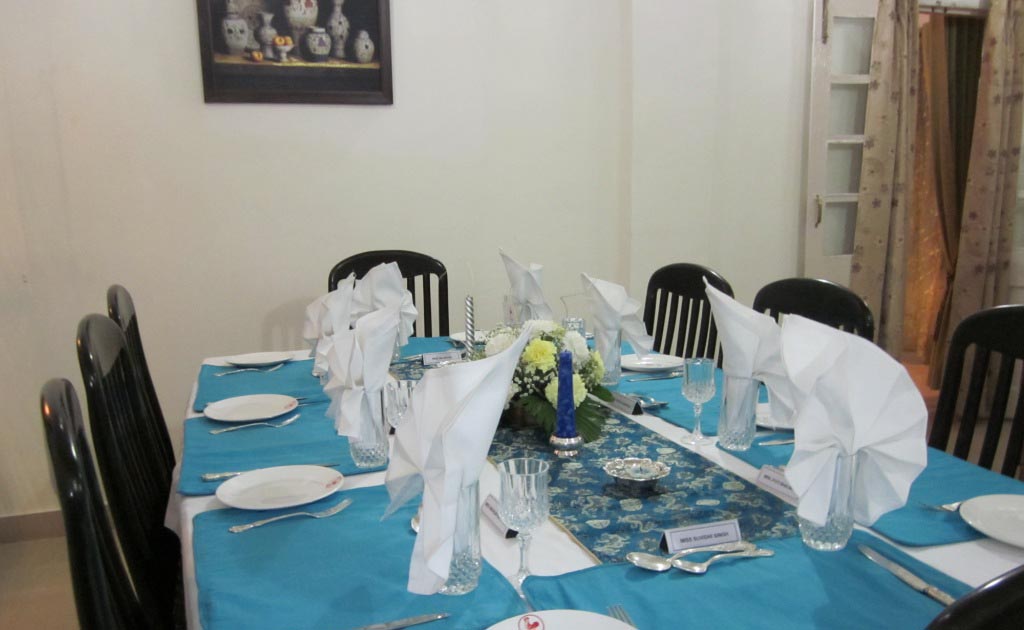

My name is Tanushree Agarwal. I belong to Jaipur, the capital of Rajasthan, India. But from the past year I have been studying in Bangalore in Srishti College of Art, Design and Technology.
Family Practice
Food in my family is mostly seen as substance that one consumes so as to fulfill their hunger needs and stay healthy. No one in my family spends too much time thinking about what they are going to eat, whereas I will spend time considering what kind of food I will be eating at home, or select where I eat out deliberately. So considering this, the food that is cooked at my house is a bit monotonous and repetitive, every day lunch always includes chapatti, pulses and a vegetable, and dinner usually has two vegetables with chapatti and some sweet. On the other hand breakfast has a bit of variety, everything from South Indian dosas and idlis to sandwiches and cereals is served.

In my house, we usually have a cook who comes once or twice a day to prepare the meals for my parents and me. The cook arrives an hour before lunch or dinner, and once she is done cooking she will leave the dishes on the stove, so that we can heat and eat when are ready.
My mother just hates cooking especially making chapatti is like a nightmare for her. She hates to be in the kitchen and prepare food for others. And even if she manages to make something for us, then we have to make sure we eat it quietly without nagging otherwise we will have to face a whole lot of complaining from her about how we never enjoy the food she cooks. But in the end I just feel happy about the fact that she at least tried to cook something for us and I must say she is not that bad. On the weekends my dad also likes cooking. He mostly cooks non-vegetarian for me and my brother. He is the kind of person who likes following new recipes every time he takes over the kitchen and adding some of his own secret ingredients in whatever he cooks.
The way my family eats has changed significantly since we went from living in a joint family to living separately. Earlier, my grandfather was quite particular with whatever we ate. And back then we all used to have lunch and dinner with the family sitting and eating on one table.
My family tends to draw on general Indian cuisine – not paying too much attention to any one regional style. Even though my family has lived in Rajasthan for over 2 generations, Rajasthani food is only cooked in my house about once a year.
There are three basic things in the Rajasthani authentic cuisine. One is the batti, which is like a bread with a lot of butter, then there is the dal which is a Hindi word for pulses and third thing includes a sweet called churma. Then other than these there are things like vegetables, curd, rice and pickle served with it. It is a task to eat the whole thali (plate) of food that is served. The main reason is because all of it is quite heavy and also not very easy to cook.

On some occasions even I like trying out new recipes. But mostly I do not enjoy cooking Indian food and rather like trying out different cuisines. Things that I cook most often include cakes, cheesecakes and tiramisu.

I mostly developed this fascination for food and trying out new things because of my neighbors back at home. They own a big restaurant in Jaipur, Rajasthan and whenever I visit their house (which is almost everyday) I am made to try some dish or the other. They even bake from home and the cakes they make are just mind-blowing. Looking at them cook I also wanted to know more about cooking. At a point I thought of taking up cooking as my career but somehow it just did not work out.
YUM food
Strawberry Yogurt.

I am just crazy about it. From when I was a child I have always loved curd in general.

But my liking for flavoured yogurt started when I moved to Bangalore. Back at home we always ate home made curd and I used to think flavoured curd would taste horrible but when I tried it here, I knew I could not stay without eating it again and again. I usually eat packaged yogurt. I do not prefer any brand, if I see strawberry yogurt written on any container, I would just buy it without giving it a second thought.
Chicken Momos/dumpling.

It is a Tibetan dish. Momos are made with flour and water dough and is stuffed with a variety of fillings such as vegetables, chicken, beef and many more. They are then steamed and served with a red chilli sauce.
I can survive on momos if gotten a chance. In Banagalore I feel a little depressed about the fact that I do not get them at the place where I stay. I have to travel like two hours just to eat good and authentic chicken momos, which does not happen often. I love every part of it- the juiciness, the steam coming out, the smell and also the spicy sauce served with it.
Pav Bhaji

The authentic North-Indian preparation with a large amount of butter, spices and the soft bread served with it makes me drool and want it all the time. I can eat Pavbhaji anywhere and everywhere. I love eating it with lots of onions and lemon. It is again an item that I crave for in Bangalore. I do not find any authentic place nearby that serves good North-Indian Pavbhaji but I still manage with what I get, as long as it is edible. Back at home, this is one dish that my mom has to cook for me and she cooks it quite well. The best part about it is that one can add any vegetable in it and cook it and you wouldn’t even realize what all is added into it. So I always feel satisfied after eating it as I feel a lot of nutritious vegetables have gone inside my body, which otherwise I would avoid eating.
FoodLab Bangalore – is a 3 week workshop the Center for Genomic Gastronomy conducted with sophomores from the Srishti School of Art, Design & Technology in the fall of 2011. Students will examine innovation and conservation in South Asian food cultures, building on recent research of the Center (utopian cuisines, mutagenic meals) and working towards the next edition of the Planetary Sculpture Supper Club to be held in Bangalore on Nov. 12th.
Follow the conversation all week here on our Blog, join in the comments and use the twitter hashtag #foodlabbangalore to keep up to date.










 My tongue is given a lot more preference than my stomach. Studying in a boarding school where good food is a luxury, translates into eating a lot of good food when it has been spotted.
My tongue is given a lot more preference than my stomach. Studying in a boarding school where good food is a luxury, translates into eating a lot of good food when it has been spotted.


























